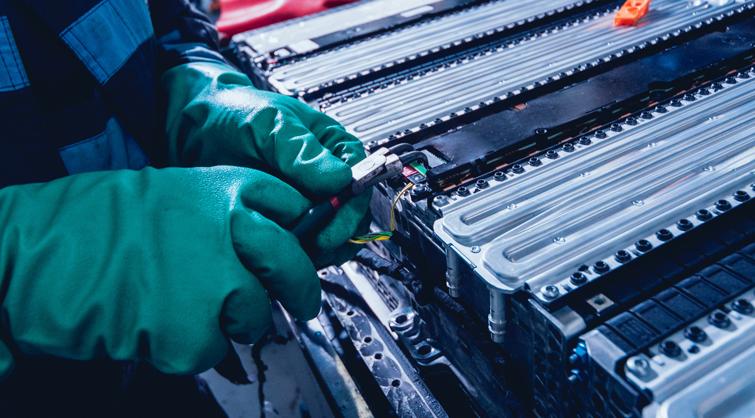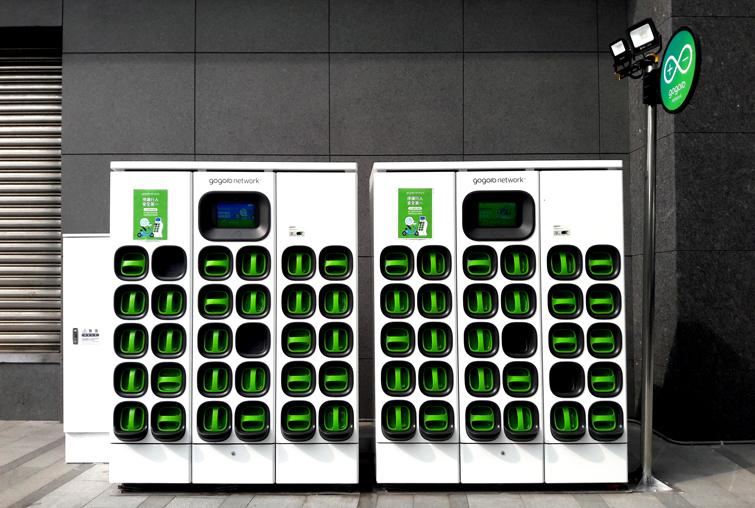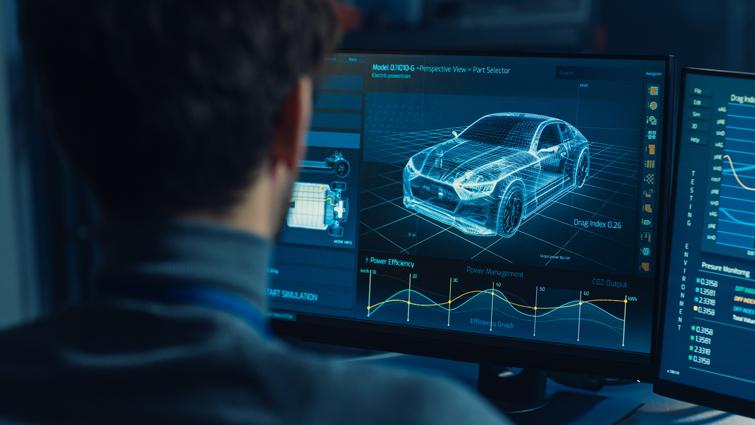Liu Jing, Professor of Accounting and Finance, Director of Investment Research Center, CKGSB Li Zhen, Chairman and CEO of Gotion Hi-tech Co.
The development of electric vehicles (EV) is playing an important role in both China and the world’s path to carbon neutrality. Global sales have risen from tens of thousands of vehicles a decade ago to 6.5 million in 2021, representing an annual compound growth rate of 57%. In China alone, sales have reached 3.52 million units.
The development of electric vehicles has accelerated significantly particularly in the past two years. The market penetration rate in Europe has risen from 3.6% of new car sales in 2019, to 14% in the first half of 2021. In China, this penetration rate has reached around 20% in recent months – up from 10% prior to 2021. The American and Japanese EV markets were initially sluggish, but they, too, are picking up speed now. Meanwhile, in the United States, the market penetration rate of new car sales increased from 1.9% in 2019 to 3.2% in the first half of 2021.
In light of new zero-carbon energy plans set out by governments and the electrification schedules of the major automobile companies, we anticipate that by 2030 the market penetration rates of electric vehicle sales in the automobile sector will reach 40-50%, and by 2050, almost all fuel vehicles will be replaced by electric vehicles.
The momentum these companies are gathering can be seen by their high performances in stock markets. Tesla, the bellwether, has a market value of over USD $1 trillion, which is higher than the combined valuations of Toyota, Volkswagen, General Motors, Hyundai Motors, Ford and BMW. Moreover, the combined value of the rising forces in the China’s EV sector: NIO, XPeng and Li Auto, has surpassed USD $100 billion. The market value of the EV battery manufacturer Contemporary Amperex Technology (CATL) has now surpassed that of PetroChina – Asia’s largest oil and gas producer. This is evidence that the era of electric vehicles has arrived, and it brings huge commercial value.
The automobile industry traditionally has a long value chain. BMW, for example, has more than 12,000 suppliers located in 70 countries around the world. In terms of downstream sales and services, in China there are approximately 30,000 car dealers and 300,000 repair and maintenance companies, which in total employ a workforce of around 3 million. Hence, the transition to electric vehicles will not only affect traditional car companies themselves, but also deeply affect industry upstream and downstream in the value chain. However, this also opens up new channels of opportunities, five of which will be explored in this article.
1. The Blowout Growth of the EV Battery Industry
The channel that has received the most direct impact from the development of the EV vehicles is the EV battery industry. EV batteries account for approximately 40% of the cost structure of low-end electric vehicles. Batteries are also a determining factor in the vehicle’s performance. The fast development of electric vehicles and their ability to compete with traditional automobile companies has been enabled by declining costs and an increase in performance levels, which itself has been driven by advances in battery technology and economies of scale. In the past 10 years, the industry’s average battery storage capacity has roughly tripled, and costs have declined by 90%.
The development of the EV industry has ushered in many opportunities for the EV battery. It is predicted that by 2030, the global battery market will reach 3,000 gigawatt-hours (GWh), which is 20 times larger than in 2020. In addition to battery-manufacturing, a large area of development for battery companies is in energy storage. As energy resources shift to renewables (particularly with the rise of wind and solar power) there will be many opportunities in the energy storage sector. We estimate that by 2030, the global energy storage market will reach 1,000 GWh.
The EV battery industry itself also created or developed many smaller industries, such as the mining of nickel, cobalt, lithium and aluminum, the chemical production of phosphorous for lithium iron phosphate batteries (lithium batteries with more efficient charging), separators (which keep battery electrodes separate), liquid electrolytes, equipment manufacturing, battery recycling and other related industries.
China’s EV industry is the most competitive in the world. In the last two years, battery exports made up approximately one-half of those worldwide. China also continues to dominate global battery supply chains. In 2021, Chinese companies accounted for 86% of the global market share in the field of anode materials and liquid electrolytes. However, one of the challenges the EV industry in China is facing is its large external dependence on upstream mineral resources. In order to combat this challenge, in the past two years China’s largest EV battery manufacturers, CATL and Gotion High Tech, have built factories overseas. In the future, there will be a few large multinational battery companies, such as these, which will exert a large influence on global supply chains.

2. Electric Vehicles Enter a New Era of Competition
The second channel of opportunity stems from the rise of electric vehicles changing the concept of vehicle manufacturing. In recent years, we have seen Tesla go from an outsider to the biggest player in the industry. We have also seen the rise of Chinese EV companies NIO, XPeng and WM Motor Technology, independently operated brands like Aion, ARCFOX, Voyah and ZEEKR, and new American companies like Lucid and Rivian. We have witnessed technology companies like Huawei cross into the vehicle manufacturing sector. Such fluid business environments would not have been possible in the traditional vehicle manufacturing sector.
The structure of the traditional manufacturing sector is very complicated. It has a high technology threshold, strict patent barriers, and a whole range of complex technical and engineering challenges, such as the building of engines, gearboxes, and chassis technology, which are all tied to the vehicle’s safety performance. The combination of these factors creates a very high ‘barrier to entry’ in the industry.
Moreover, the sales and maintenance model of the industry creates a network effect whereby enterprises can gain competitive advantage through customer loyalty; this makes it difficult for smaller companies to compete. Taking the United States as an example, from the birth of the industry up until the 1970s when Japanese automobile companies entered the U.S. market, the industry was dominated by the ‘big three’: Ford, General Motors and Chrysler, which always held at least 80% of the market share. Before the rise of Tesla, it was very difficult for an outsider to enter the market and achieve success.
By replacing engines, gearboxes and fuel tanks with batteries, electric motors and electric control systems, EV companies significantly reduced the complexity of the automobile manufacturing process. Engines in a traditional fuel vehicle would contain at least 2,000 moving parts – with the introduction of the electric vehicle this was reduced to 20. Such a reduction in complexity largely reduced the value of the patents and knowledge that fuel-based vehicle giants had built up over the decades.
The lowering of the vehicle manufacturing threshold has had a profound impact on the competitive landscape of the industry. The market stability from the fuel vehicle era is being disrupted and the era of electric vehicles is set to bloom. Although giants in the EV industry have had their share of success in experiencing rapid growth, from 2019 to the first half of 2020, the market share of the top 10 EV companies fell from 63.2% to 56.7%. In this new era, there are opportunities for both newcomers and old forces in automobile manufacturing. The new forces entering the industry often have a digital product mindset, and in their product structure modelling they do not carry any baggage from the past. These companies often have the tenacity and willingness to try new strategies.
Although traditional car manufacturers have been slow in terms of electrification and automation, they have now mostly come to terms with the direction of the automobile industry and have made plans to invest large amounts of resources to carry out this transformation. Volkswagen, for example, plans to invest a total of EURO 159 billion in the next five years, of which 89 billion will be directed towards EV technology and digitalization. By 2030, the number of its purely electrical vehicles will rise to 50%, and by 2040, it will only manufacture electric cars. Toyota has also invested USD $70 billion to electrify its vehicles by 2030, half of which will be invested in developing a battery electric vehicle line-up.
The lowering of the entry threshold has given Chinese EV companies a historic opportunity to overtake other manufacturers. Due to the government’s support for the sector, several companies have been able to gain a first-mover advantage. Currently, China has the largest EV market in the world and the most complete battery supply chain. Internet giants like Huawei and Baidu are also providing intelligent infrastructure for the industry. The combination of these advantages suggests a bright future for the industry in China.
3. Developments in Software and Digitalization will be a Major Trend
The third channel of opportunity is the trend towards digitalization and software advancements. In the 1970s, only 3.6% of a vehicle’s cost included these elements, however, in 2020 they made up 35%. In comparison to the complex mechanics of fuel vehicles, electric vehicles have batteries, electric motors and electric control systems which all simplify the control of the vehicle: they make signal transmission more convenient, and the control of voltage and current more sensitive. The result is that such cars are more suitable than fuel-based cars for the development of electronics and software.
In an electric vehicle, the most fundamental aspect of the vehicle’s architecture is the control system, the autonomous driving system, and the smart cockpit system. The control system is responsible for the operation of the chassis, braking, vehicle safety, and directing the car to carry out basic driving functions. The autonomous driving and smart cockpit systems are more focused on interactions between the vehicle and the operating environment, as well as those between the person and the vehicle. All these systems rely on chips, software, and algorithms to carry out their functions.

In terms of electronic hardware, EVs have been built as a “computer”. Taking Huawei’s automotive product planning as an example, one electric vehicle requires various kinds of chips: the Kirin 9000 (an SEO chip), the Ascend 310 (an AI chip), the Kunpeng 920 (a CPU chip) and Balong 5G01 (a 5G chip), as well as various microcontrollers – small microcomputers all contained on a single chip. Moreover, these various chips carry out functions in a vehicle related to driving, control, and entertainment. One of the most important uses for these chips is to process the vast amounts of data collected by the increasing number of cameras which are being deployed on electric vehicles. For example, when NIO released its new ET7 model in 2021, in addition to fitting four NVDIA Orin SoC chips inside its autonomous driving controller, it also installed a high-resolution LiDAR, a 5-millimeter wave radar, 12 ultrasonic sensors and 11 HD cameras.
In the future, it is estimated that for level 4 autonomous driving, a vehicle will need to process 4.8 billion bytes of data per second – this is equivalent to the computing power of nine iPhones. This means there is huge opportunity in the hardware market. By 2030, the automotive chip market is expected to grow to USD $115 billion, which will account for 11% of the entire chip market.
Electric cars are very much software-based products. Automotive chips provide the computing power, but software and algorithms are needed to enable this power. In some modern and high-end electric vehicles, the software can be comprised of up to 100 million lines of code. In comparison, the Boeing 787 Dreamliner jet only uses 6.5 million lines of code and its F35 jet only 24 million. As vehicles become more intelligent and automated, control systems will need to improve their response time and control capabilities, automated driving systems will need to improve the accuracy and security of their algorithms, and the intelligent cockpit system will need to support more diverse applications and services. With electric vehicles becoming increasingly based on software, many technology companies, already possessing strong software divisions, have successfully been able to move into the electric vehicle sector. Software is also the biggest shortcoming of traditional automobile manufacturers and represents a challenge they may face in their electric transformation.
4. The Maturation of Autonomous Driving
The fourth area of opportunity is the move toward autonomous driving: an important step in the evolution of electric vehicles that is going to bring about major changes to transportation. “Driving” requires a large amount of manpower, cost, and time. In China, there are approximately 410 million people who hold a driving license; suppose it takes 100 hours for every person to learn how to drive, in total 460 years would be spent on this process. Moreover, supposing that the average driving license holder spends 50 hours every year on the wheel, according to the most recent calculations of the average salary in China, that would be equal to an output loss of RMB 860 billion (USD $135 billion).
In China, there is a lot of manpower being invested in the driving profession. There are approximately 3 million taxi drivers, 30 million registered online ride-hailing drivers and 30 million truck drivers. In the logistics sector, drivers account for 10% of the cost of the entire chain. Such data points to the fact that social costs would be significantly reduced if driving were to be automated.
According to recent estimates, based on a 5-year operation cycle, the cost of operating a self-driving taxi can be reduced by RMB 330,000 (USD $51,835) compared to running a ride-hailing taxi. Another analysis revealed that in the United States, a 10% autonomous driving penetration rate would save USD $37.7 billion in social costs every year. If 90% of all cars were autonomous, the U.S. would save USD $447.1 billion annually.
Self-driving vehicles not only save a large amount of labor cost, they also greatly improve social capital and traffic efficiency, improving congestion and lowering collision frequency. In the third quarter of 2021, Tesla’s Autopilot ADV technology participated in a test that found the car was involved in a collision every 8 million kilometers. In the same period, the average distance for a vehicle in the United States to be involved in a collision was 780,000 kilometers, thereby indicating safety is increased by 10 times in self-driving vehicles. In addition, as the technology of autonomous driving develops further, it is expected that they will become increasingly safer.
According to recent predictions, global exports of autonomous vehicles that are at level 3 or above will increase from 32,000 vehicles in 2020 to 863,000 in 2024 (a 128% increase on an annualized basis). Autonomous driving has already begun to be applied in various modes of transport, such as in taxis, delivery vehicles and long-distance cargo transportation. Many Chinese companies have piloted driverless taxi services, such as Baidu, Antu, Didi, WeRide and Pony.ai.
5. The Radical Changes in the Automotive Ecosystem
The final channel of change and opportunity is the impact which the development of electric vehicles is having on the automotive ecosystem. Upstream energy supply is changing from oil to electricity, and the means to supplement this energy is changing from refueling to charging and battery swapping. This transition is itself creating new industries, such as EV charging piles, battery swapping stations and battery recycling. There is also a transformation underway in the sales and service industries downstream.
As the most used method of EV supplementation, charging piles have been continually increasing in recent years. At the end of 2021, there was a total of 2.6 million in China, with a compound growth rate of 65.3% in the past five years. The ratio of EV charging piles to EV’s has also reduced in China from 7.8:1 in 2015 to 3:1 in 2021. As the EV market penetration increases and the EV charger to EV ratio decreases, it is expected that by 2025 the EV charging pile market will reach RMB 250 billion (USD $39 billion). Charging technology is also constantly developing. According to the plans of major EV companies, by 2025 800v fast charging will be implemented, which will have the potential to rival the time it takes to refill a traditional fuel vehicle.
Furthermore, the number of battery swapping stations in China is growing exponentially. At the end of 2021, there were 1298 stations (of which 777 were owned by NIO), increasing year-over-year by 134%. Due to the relatively long time it takes to charge an EV at an electric pile at their current stage of technological development, as well as the strain they cause to land resources and the grid, battery swapping has become a viable and convenient alternative. Moreover, the introduction of battery leasing services has heavily reduced the initial purchasing costs of electric cars.
The battery market is expected to increase rapidly, particularly as companies like NIO, BAIC Group and Dongfeng decide on their future OEM models, and EV battery companies like CATL release their plans for standardization. Many institutions estimate that battery swapping stations will increase to 20,000 by 2025, and that the market could reach RMB 260 billion (USD $40.8 billion).

A battery life is usually 5-8 years. After recycling the battery, the retired battery material can be recovered to be re-used. As electric vehicles become more popular in the future there will likely be a surge in battery retirement, which will make the battery recycling industry increasingly important. According to agency forecasts, there were 200,000 retried batteries in 2020, which by 2025, is expected to increase to 780,000. As of September 2021, there were 171 battery recycling enterprises in China, with 9,985 battery recycling sites established across various regions. In China, there are also many electric vehicle companies that have set up integrated recycling plants, such as CATL and Gotian High Tech.
The development of electric vehicles has also made great changes in vehicle sales and service markets. Electrification has greatly reduced the number of parts required to manufacture the vehicles – which in turn has lowered demand for repair and maintenance. The number of parts required to manufacture a fuel vehicle is as high as 100,000, with 10,000 parts needed for the motor alone. There are only 10,000 parts in total in an electric vehicle -one-tenth of the amount in fuel vehicles.
Since oil does not need to be replaced and the motor managed, mechanical component failures are far less common, which reduces the need for the vehicle to be serviced. According to estimates, after-sales maintenance costs for electric vehicles will be reduced by as much as 40% compared with fuel vehicles of the same age. Traditional car dealers received 60% of their profits from repair services – clearly in the automotive aftermarket, electric vehicles are going to disrupt traditional business models and force companies to adjust.
Automation and software advancements are changing the way vehicles are maintained and upgraded. Performance optimizations and bug fixes can now be carried out by remote software over-the-air (OTA) updates. A typical example is the problem of long breaking distance after Tesla’s release of its Model 3. Traditionally, this kind of problem would have been solved by a large-scale recall or sending it to a dealer to replace the parts. In Tesla’s case, their engineers upgraded the braking system via OTA programming in several days, reducing the breaking distance by six meters and greatly improving the vehicle’s safety. Therefore, it is evident that the new forces in electric vehicle manufacturing are more equipped to facilitate sales and servicing networks. As traditional car manufacturers electrify their vehicles, it will be of utmost importance for them to optimize their sales and servicing models.

The EV revolution that is underway is a global historic shift that could be compared to the Internet revolution. It is a revolution that has the potential to solve challenges that are affecting the survival and development of humankind, such as climate change.
The development of electric vehicles has greatly impacted related industries, opening up new channels and opportunities. It will create an upstream EV battery industry; it will change the competitive landscape and models of traditional enterprises, both in vehicle manufacturing and the automobile aftermarket; and it will promote other channels, such as digitalization, software advancement and automation. The development of electric vehicles and the influence which these channels will have in the next ten years on the global economy will be huge. It is also a means for the world to achieve its carbon neutrality goals. Lastly, it is a major opportunity for Chinese companies in the automobile sector and related industries to have a global influence and impact people’s daily lives.






















